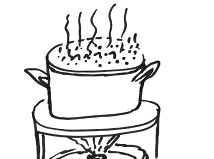• You type mathematical commands, then press the RETURN key on your
keyboard.
• Type x^3 then press RETURN. This is how to type x³.
• Now type 2*x+3*x and press RETURN. Notice that wxMaxima automa-
tically simplifies this to 5x.
• Look at the wxMaxima manual (choose Maxima help in the Help menu).
• Find new commands to try out.
• Spend time practicing. wxMaxima is quite difficult to get started with, so
it is important to practice.
Note: You must not use graph or wxMaxima to answer exercise questions for
you! Instead, you should try different examples of calculations and operations
to make sure that you understand how they are done, so that you are better able
to do them without the support of the software.

African Virtual University
Web References
WOLFRAM MATHWORLD (VISITED 07.11.06)
http://mathworld.wolfram.com/
Wolfram Mathworld is an extremely comprehensive encyclopedia of mathematics.
This link takes you to the home page. Because Calculus is such a wide topic, we
recommend that you search Mathworld for any technical mathematical words
you find. For example, start by doing a search for the word ‘limit’.
Wikipedia (visited 07.11.06)
http://en.wikipedia.org/wiki/Main_Page
Wikipedia is a general encyclopedia. However its mathematics sections are
extremely good. If you don’t find what you want at Mathworld, try searching at
Wikipedia. It is often good to check both, to see which is easier to understand.
MacTutor History of Mathematics (visited 07.11.06)
http://www-history.mcs.st-andrews.ac.uk/HistTopics/The_rise_of_calculus.
html
Read for interest, the history of calculus.
Key Concepts
Limit of a function
A function f ( x) has a limit L as x approaches point c if the value of f (x)
lim
approaches L as x approaches c, on both sides of c. We write
f (x) = L
x
.
→ c
One sided limits
A function may have different limits depending from which side one approaches
c . The limit obtained by approaching c from the right (values greater than c ) is
called the right-handed limit. The limit obtained by approaching c from the left
(values less than c ) is called the left-handed limit. We denote such limits by
lim
lim
+
f (x) = L ,
−
f (x) = L
+
x → c
−
x → c

African Virtual University
Continuity of a function
A function f ( x) is said to be continuous at point c if the following three condi-
tions are satisfied:
• The function is defined at the point, meaning that f (c) exists,
• The function has a limit as x approaches c , and
• The limit is equal to the value of the function. Thus for continuity we must
lim
have
f (x) = f (c) .
x → c
Continuity over an Interval
A function f ( x) is continuous over an interval I = [ a, b] if it is continuous at each interior point of I and is continuous on the right hand at x = a and on the
left hand at x = .
b
Discontinuity
A function has a discontinuity at x = c if it is not continuous at x = c . For exam-
sin x
ple, f (x) =
has a discontinuity at x = 0.
x
Jump discontinuity
A function f is said to have a jump discontinuity at x = c if
f ( x) = M
lim
,
x c
®
f ( x) = L
lim
, but L M .
x c+
®
Removable discontinuity
A function f (x) has a removable discontinuity at x = c if either f (c) does not
exist or f (c) ≠ L
Partial derivative
A partial derivative of a function of several variables is the derivative of the
given function with respect to one of the several independent variables, treating
all the other independent variables as if they were real constants. For, example,
if f (x,y,z) = x 2 y+3 xz 2 − xyz is a function of the three independent variables, x, y, and z, then the partial derivative of f with respect to the variable x is the
function g (x,y,z) = 2xy+3 z 2 − yz.






African Virtual University
Key Theorems and/or Principles
Intermediate Value Theorem for Continuous Functions
If f is continuous on [ a, b] and k is any number lying between f ( a) and f ( b) then there is at least one number c in ( a, b) such that f ( c) = k.
Continuity of a differentiable function
If f is differentiable at c then f is continuous at .
c
Learning Activity
Engaging Stories
(a) Story of shrinking areas
Consider the geometric pattern resulting
from a process of inscribing squares
inside a given square in the following
manner:
Start with a unit square S . In S inscribe
0
0
a square S whose vertices are the mid-
1
points of the sides of S . In S inscribe
0
1
a square S whose vertices are the mid-
2
points of the sides of S . Carry out this process a number of times to obtain the
1
squares S , k
.
k
= ,
1
,
3
,
2 4
Questions
1. How far can one go in inscribing such squares?
2. What happens to the areas of the inscribed squares S as the inscription
n
process is continued?
3. What are the areas of the squares S , k
?
k
= ,
1
,
3
,
2 4








African Virtual University
(b) Story of evaporating water
Francis is a nurse at the village health centre that is close to his house. One af-
ternoon during lunch break Francis decided to dash home and prepare himself a
cup of tea. He went to the kitchen, poured some water into a cooking pot, lighted
the kerosene stove and placed the pot on to boil the water.
While waiting for the water to boil, Francis quietly settled in a couch, opened
his radio and listened to the latest news broadcast. Unfortunately, he got carried
away by the live news being aired on the war that was being fought in Lebanon
and forgot all about the water that was boiling in the kitchen.
Questions
1. What do you think was happening to the
volume of the boiling water as time passed
by?
2. What will happen to the volume of the water
in the pot if Francis forgets all about what he
came back home for?
(c) Story of a washed away bridge
Jesika is Headmistress of a school which lies a
short distance but on the other side of a river that separates her village from
the school. To go to school Jesika walks along a road which goes over a bridge
that joins the two villages.
One morning Jesika could
not reach her school. The
bridge had been washed
away by floods caused by
a heavy downpour of rain
that occurred the night
before.
Questions
1. Was the road from Je-
sika’s home to school
continuous after the bridge had been washed away?
2. How could one make the road from Jesika’s home to school once again
passable?

African Virtual University
The first two stories in the introduction relate to the concept of limit of a func-
tion. Referring to the questions raised at the end of the first story you will most
likely have arrived at the following correct answers:
1. Answer to Question 1: The process of inscribing the squares is unending.
However, after only a few steps one is forced to stop the process because the
sides of the squares become too small to allow further visible bisection.
2. Answer to Question 2: The areas of the inscribed squares get smaller and
smaller as n increases.
3. Answer to Question 3: If we denote the area of square S by A then one
k
k
finds A = 2-1,
A = 2-3,
A = 2-5,
A = 2-7.
1
2
3
4
In general, one finds the area of the square S to be
A = 2-(2n -1).
n
n
These answers, and especially the answer to the third question, reveal that as n gets
very large the areas of the squares get very small, ultimately shrinking to zero.
The same experience is made from the answers to questions raised in connection
with the story of the boiling water. As time passes by, the water evaporates and
hence its volume in the pot decreases. If left unattended, the water will evaporate
completely and the volume of after left in the pot will be zero and thereby creating
a high risk of causing fire in the house!
The third story relates more to the concept of continuity of a function. The road
from Jesika’s home to the school represents the curve of a function. When the
bridge is in place the road is in one piece. It is continuous. When the bridge is
washed away by the flood waters the road is disconnected. The function is then
not continuous. To make it once again continuous one must construct the bridge.
In this case the discontinuity is removable.

African Virtual University
Mathematical Problems
Determination of Limits
Without leaning on relevant stories such as the ones given above, the limit concept
is pedagogically difficult to introduce starting directly with a mathematical exam-
ple. However, now that we have broken the ice, we are ready to confront directly
a mathematical problem.
2
x − 4
Problem: Find the one-sided limits of the function y =
as x tends to 2.
x − 2
Does the function have a limit at 2? Determine whether or not the function is
continuous at x = 2 . If it is not continuous discuss whether or not the disconti-
nuity is removable.
Note that the function is not defined at 2. However, this should not bother us
much because “tending to 2” does not require being at the point itself. Indeed,
this is a very important observation to make regarding limits. The function need
not be defined at the point. In order to solve the problem let us investigate the
behavior of the function as x approaches 2 by evaluating it at values close to 2
on both sides of 2:
X
y = f (x)
1.5
3.5
1.7
3.7
1.9
3.9
1.95
3.95
1.97
3.97
1.99
3.99
2.0
4!
2.01
4.01
2.03
4.03
2.05
4.05
2.1
4.1
2.3
4.3
2.5
4.5
DO THIS: Draw the graph of the function.
How do you denote that the number 2 is not in the domain of the function?

African Virtual University 0
2
46–
y 2
= x2 – 4
1
23– 1
23 x – 2
From the values given in the table, it is quite obvious that, as x approaches 2
from either side, the function values approach 4 . In this case the left-hand and
right-hand limits are equal.
y
6
4
2
x
– 3
– 2
– 1
1
2
3
– 2
y = x2 – 4
x – 2
Software Task
Reproduce the graph using the software program Graph.
You will need to type into the f(x)= box: (x^2-4)/(x-2)
Experiment with other similar functions.
How can we explain this somewhat surprising result?
Examine the function more closely. Note that the expression 2
x − 4 may be
expressed as the product of two factors (x + 2)( x − 2) . We can therefore write
(x + )(
2 x − )
2
the function in the form
f (x) =
.
x − 2
Since x ≠ 2 we can cancel out the factor x − 2 and get the linear equation
y = x + 2 valid everywhere away from the point x = 2 . Sketch the graph of
y = f (x) . As x approaches 2 taking values less than 2 or values greater than 2
the function values approach 4 .

African Virtual University
Group Work
(i) Get together with a colleague or two and discuss the proofs and significance
of the theorems on limits of:
• A constant function
f ( x) = k
• Sum of two functions
f ( x) + g( x)
• Difference of two functions
f ( x) g( x)
• Product of two functions
f ( x) g( x)
f ( x)
• Quotient of two functions g( x)
(ii) Study carefully how to compute limits at infinity (involving x ® ) by
working out the examples given in pp 96-98.
Determination of Continuity
We have used the above mathematical example to demonstrate the concept of
a limit. Fortunately, the same example can be used to illustrate the concept of
continuity.
Because the function is not defined at x = 2 we can immediately conclude that
it is not continuous at x = 2 .
However, since the limit exists, the function has what is known as a removable
discontinuity. One removes such a discontinuity by defining a new function F ( x)
that is identical to the given function f ( x) away from the point of discontinuity,
and has the value of the limit of f ( x) at the point of discontinuity.
⎧ 2
x − 4
⎪⎪ x − 2
x ≠ 2
The function
F (x) = ⎨⎪
is therefore continuous at x = 2⎪⎩. 4
x = 2

African Virtual University
Group Work
(i) Get together with a colleague or two and discuss the properties of continuous
functions, related theorems and their proofs as presented in pp 84-94.
Use the Graph software to experiment with different functions f ( x) and g( x) f ( x)
Look at the graphs of f ( x) + g( x) , f (x) - g (x), f ( x) g( x) ,
.
g( x)
Write a short commentary on what you notice.
(ii) Take special note to the Intermediate Value Theorem and its applications
(pp page 86) significance of the theorems on limits of:
• A constant function
f ( x) = k
• Sum of two functions f ( x) + g( x)
• Difference of two functions f (x) - g (x)
• Product of two functions f ( x) g( x)
f ( x)
• Quotient of two functions g( x)
as given and proved in pp 44 – 48.
(iii) Study carefully how to compute limits at infinity (involving x ® ) by
working out the examples given in pp 96-98.
Exercise Questions (from Gill: The Calculus Bible)
DO THIS
Solve all the problems given in:
Exercise 2.1(pp 60-61)
Exercise 2.2 (pp 71-72)

African Virtual University 43
Unit 1: Elementary Differential Calculus (35 Hrs)
Learning Activity # 2
TiTLE: Differentiation of functions of a single variable (29 Hrs)
Specific Learning Objectives
At the end of this activity the learner should be able to:
• Determine the differentiability of a function of a single variable.
• Differentiate a given function, including: polynomial, rational, implicit and
inverse functions.
• Find higher order derivatives.
• Apply derivatives to:
(i) Evaluate certain limits of functions (L’Hopitals Rule),
(ii) Calculate relative extreme values of a function (Second Derivative Test)
and
(iii) Obtain a series expansion of a function at a point (Taylor’s series).
Summary
The derivative of functions of a single variable is a concept that is built on the
foundations already laid down by the concepts of limit and continuity. Continuity
measures zero in order of smoothness of a curve while differentiability is of or-
der one. You will soon discover that differentiability is a sufficient condition for
continuity but continuity is only a necessary condition for differentiability.
In this learning activity the derivative of a function will be defined. Rules for
differentiation will be stated. Derivatives of some special mathematical functions
will be derived. Key theorems will be stated and demonstrated and some useful
mathematical applications of derivatives will be stated and demonstrated.
Compulsory Reading
The Calculus Bible
Prof. G.S. Gill: Brigham Young University, Maths Department.
Differentiation,
Chapter 3, pp 99 – 137
Applications,
Chapter 4, Section 4.1, pp 146 – 179.

African Virtual University 44
internet and Software Resources
Software
You will be asked to complete tasks using wxMaxima in this activity.
Web References
NRich (Visited 07.11.06)
http://www.nrich.maths.org/public/viewer.php?obj_id=477&part=index&refpa
ge=monthindex.php
Read this interactive introduction to differentiation.
ASGuru (Visited 07.11.06)
http://www.bbc.co.uk/education/asguru/maths/12methods/03differentiation/


























